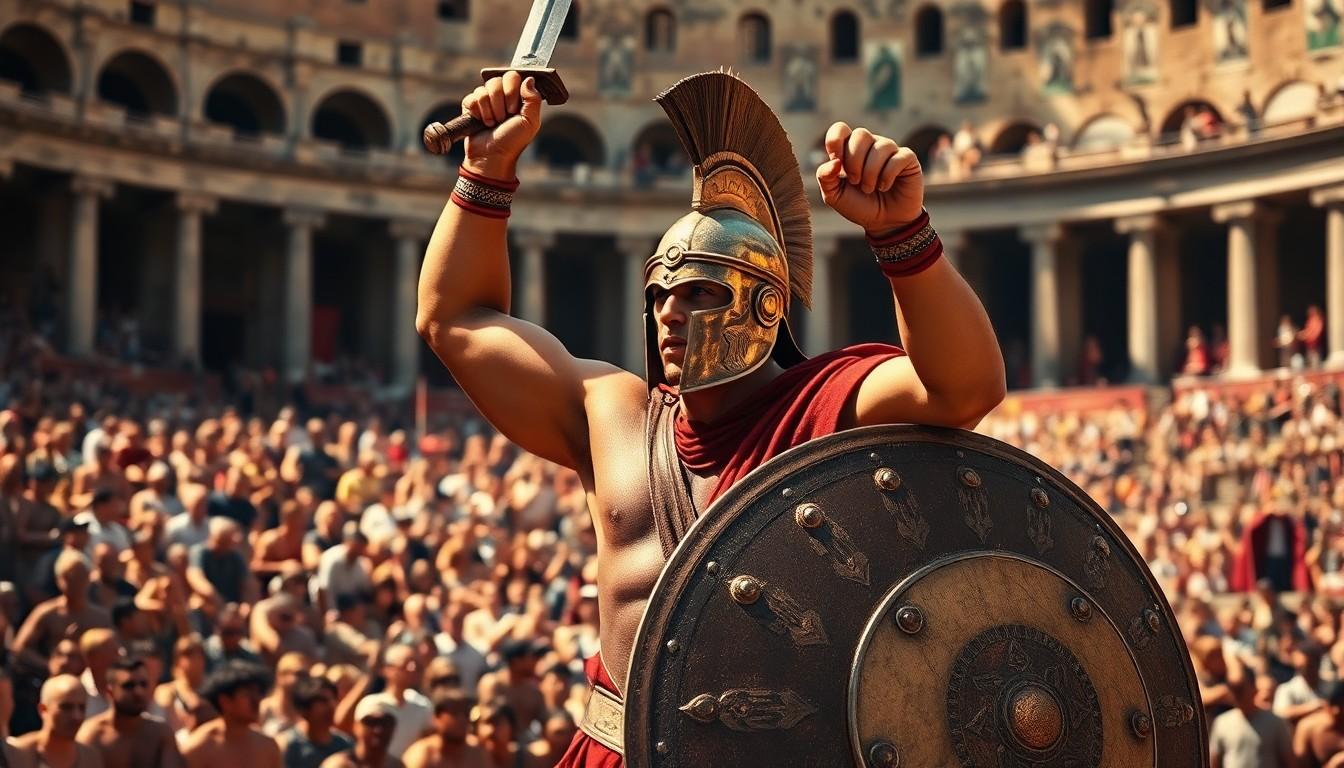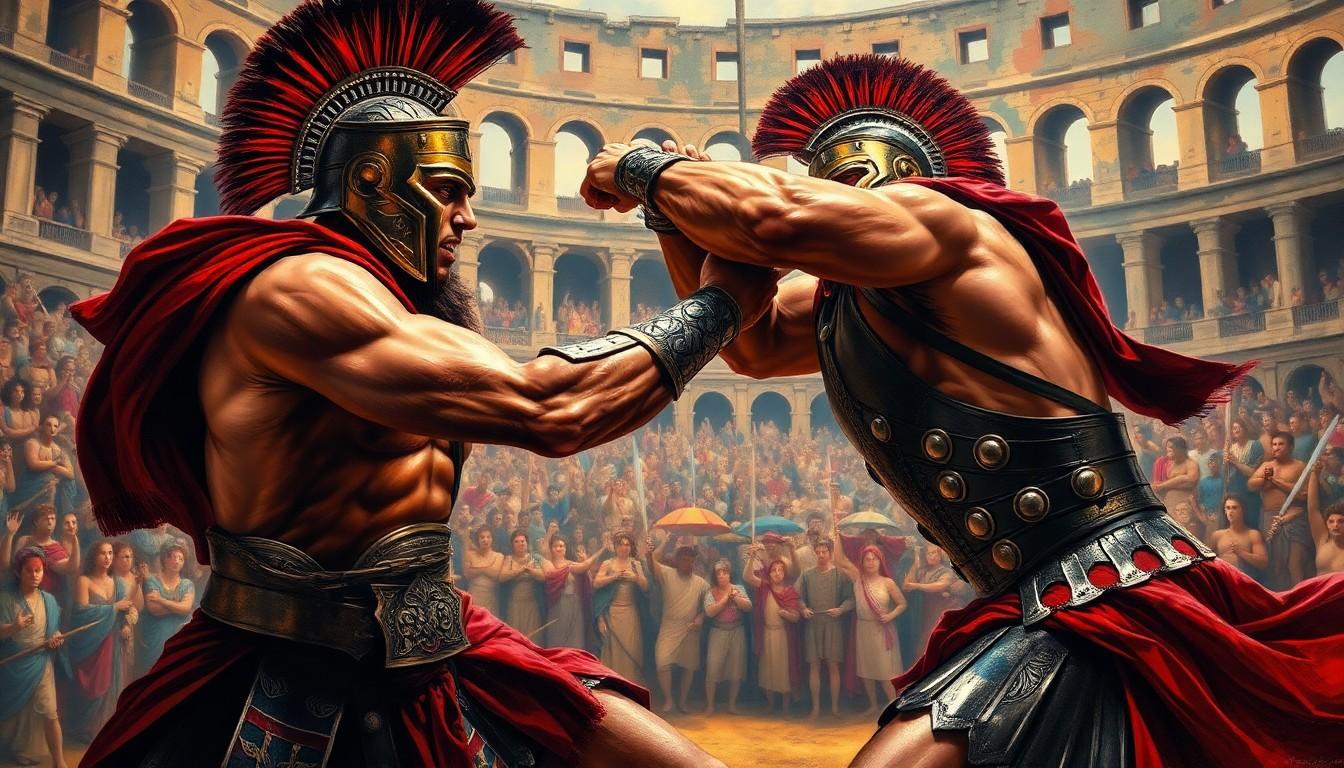In a world where art often feels confined to the walls of galleries, gladiator painting bursts onto the scene like a warrior in full armor. This vibrant genre captures the raw energy and drama of ancient Rome, making it impossible to overlook. Imagine a canvas where fierce battles and heroic triumphs come to life, all while making your living room feel like a coliseum—minus the lions, of course.
Gladiator Painting
Gladiator painting embodies the thrilling spirit of ancient Roman combat. This unique genre immerses viewers in the dramatic moments of gladiatorial contests.
Historical Context
Artisans from ancient Rome created gladiator paintings to commemorate heroic deeds and the valor of fighters. Originating in the 1st century BCE, this genre served as a reflection of Roman society’s fascination with strength and bravery. Artists often drew inspiration from actual events, immortalizing legendary battles and the lives of famous gladiators. These artworks adorned various public spaces, enhancing civic pride and celebrating the martial prowess of their culture. They provided not just decoration but also narrative, retelling stories that resonated widely across social classes.
Significance in Art
Gladiator painting holds a prominent place in the evolution of narrative art. Its vibrant depictions of conflict symbolize not only physical struggle but also moral challenges faced by individuals. The compelling imagery invites viewers to explore themes of courage, honor, and mortality. Artists employed dramatic compositions and bold color palettes to heighten emotional impact. These works influenced later artistic movements by shaping the portrayal of violence and heroism. Thus, gladiator painting transcends mere depiction, offering profound insights into the human experience and societal values of its time.
Notable Gladiator Paintings

Gladiator paintings feature remarkable artistry and profound historical significance. Various artists and their iconic works shaped this vibrant genre.
Famous Artists and Their Contributions
Several artists played vital roles in the development of gladiator painting. Jean-Leon Gerome is renowned for his dramatic compositions that capture the intensity of combat scenes. His work “Pollice verso” showcases the moment of judgment during a gladiatorial match. Similarly, Lawrence Alma-Tadema contributed imagery that reflects the grandeur of Roman culture. His paintings often emphasize the emotional weight of battle, inviting deeper contemplation. These artists’ contributions laid the foundation for future representations of gladiatorial themes in visual arts.
Iconic Works
Numerous iconic works exemplify the essence of gladiator painting. “Pollice verso” by Jean-Leon Gerome presents a gripping portrayal of the crowd’s reaction to a gladiator’s fate. The intense expressions of spectators highlight the emotional stakes of such moments. Another notable piece, “The Gladiators,” by Alma-Tadema, captures the camaraderie among fighters in a moment of respite. Rich colors and intricate details bring the Roman setting to life, enhancing its historical context. Both paintings offer valuable insights into the cultural significance of gladiatorial combat through artistic expression.
Techniques Used in Gladiator Painting
Gladiator painting showcases various techniques that enhance the vividness of the intense scenes it portrays. Artists employ specific approaches to create striking visuals that resonate with viewers.
Color Palettes
Bold color palettes dominate gladiator paintings, capturing the action and emotion of the battles. Vibrant reds symbolize bloodshed and passion, while deep blues and greens often provide contrast, evoking a sense of foreboding. Earthy tones bring depth to the backgrounds, grounding the dramatic moments. Bright highlights emphasize key elements, directing the viewer’s focus to essential characters or actions. These deliberate choices create an emotional atmosphere that immerses observers in the atmosphere of ancient Rome.
Brushwork and Style
Dynamic brushwork characterizes gladiator painting, with strokes that imply movement and urgency. Artists use loose, expressive techniques to convey the adrenaline of combat. Traditional realism blends with elements of impressionism, creating a unique visual experience. Layering of paint adds texture, inviting viewers to appreciate the details of armor and muscle. Each artist’s style contributes to the narrative, allowing for personal interpretations of heroic themes and intense struggles, ultimately enhancing the storytelling aspect of the paintings.
Themes Explored in Gladiator Paintings
Gladiator paintings explore various themes that resonate with viewers. The genre delves into the complex emotions tied to ancient Roman life, showcasing the multifaceted nature of gladiators.
Valor and Honor
Valor and honor serve as central themes in gladiator paintings. Artists capture the bravery exhibited by gladiators, emphasizing their willingness to face life-threatening challenges. Paintings often depict the fighters poised for combat, radiating confidence amidst the chaos. Powerful visuals illustrate the mutual respect among warriors, highlighting bonds forged through shared experiences. The portrayal of victory becomes symbolic, representing societal ideals of courage and honor in the face of adversity. Iconic pieces elicit admiration for their subjects’ strength, reflecting the admiration gladiators earned from the public.
Life and Death
Life and death loom large in gladiator paintings, representing the ultimate stakes of combat. Dramatic scenes encapsulate the fragility of existence, illustrating the tension between survival and demise. Immediate danger becomes palpable, as intense expressions reveal the fighters’ emotional struggles. Recurring motifs depict fallen gladiators, prompting reflections on mortality and the cost of glory. The contrast of vibrant colors against somber themes evokes a powerful emotional reaction. Audiences engage with the narratives, confronting the harsh realities faced by gladiators and contemplating the line between life and death in the arena.
Modern Interpretations of Gladiator Painting
Modern interpretations of gladiator painting reflect the genre’s enduring power. Artists today reinterpret themes of courage, honor, and mortality through contemporary lenses.
Influence on Contemporary Art
Contemporary painters draw inspiration from the dynamic energy of gladiator painting. They infuse modern techniques and issues into their works, creating fresh narratives that resonate with today’s audiences. Color palettes echo the bold hues of classical art while incorporating more abstract elements. Many artists explore themes like violence and sacrifice in modern environments, highlighting the eternal relevance of gladiatorial themes. These artworks invite reflection on the nature of combat, identity, and societal values.
Popular Culture References
Gladiator painting influences various aspects of popular culture. The visuals inspire movies, video games, and literature that tackle themes of combat and valor. Films set in ancient Rome often showcase vivid portrayals of gladiatorial battles, reflecting the genre’s dramatic essence. Video games frequently feature gladiator combat as a core mechanic, engaging players in immersive narratives. Television series also depict characters reminiscent of historical gladiators, emphasizing the eternal conflict between honor and survival. These cultural references highlight the lasting impact of gladiatorial artistry on storytelling in modern media.
Gladiator painting remains a powerful testament to the cultural and artistic heritage of ancient Rome. Its vivid depictions of bravery and conflict continue to resonate with audiences today. Through the dynamic compositions and emotional depth of these artworks, viewers are drawn into the world of the gladiators, experiencing the thrill of combat and the weight of honor.
As modern artists reinterpret these themes, the legacy of gladiator painting endures, influencing contemporary art and popular culture. The genre not only celebrates the valor of its subjects but also invites reflection on the complexities of life, death, and the human spirit. This enduring fascination ensures that gladiator painting will continue to captivate and inspire future generations.




